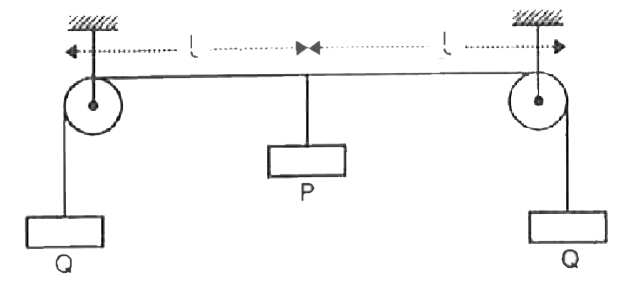Calculate of velocity v of the falling masss P after it has gone down by x in an axle and wheel system of radii r and R respectively (Figure 2.12)
![Calculate of velocity v of the falling masss P after it has gone down by x in an axle and wheel system of radii r and R respectively (Figure 2.12) [Hint : Let Q go up by y when P down by x Then (x)/(y)=(R)/(r) :. x=(R)/(r)y Apply work-energy theorem to the system (P+Q+ceiling). Remember that the gravitational pulls are the lone forces external to the system, the tensions and pull of ceiling are internal forces of the system]](https://d10lpgp6xz60nq.cloudfront.net/physics_images/NEP_NGM_PHY_GP_C07_E01_020_Q01.png)
[Hint : Let Q go up by y when P down by x
Then xy=Rr∴x=Rry
Apply work-energy theorem to the system (P+Q+ceiling). Remember that the gravitational pulls are the lone forces external to the system, the tensions and pull of ceiling are internal forces of the system]
The correct Answer is:√2gx(P−rRQ)/(P+r2R2Q)
Step by step video, text & image solution for Calculate of velocity v of the falling masss P after it has gone down by x in an axle and wheel system of radii r and R respectively (Figure 2.12) [Hint : Let Q go up by y when P down by x Then (x)/(y)=(R)/(r) :. x=(R)/(r)y Apply work-energy theorem to the system (P+Q+ceiling). Remember that the gravitational pulls are the lone forces external to the system, the tensions and pull of ceiling are internal forces of the system] by Physics experts to help you in doubts & scoring excellent marks in Class 11 exams.
Topper's Solved these Questions
- BOOK - NN GHOSHCHAPTER - FRICTION, WORK POWER AND ENERGYEXERCISE - Exercises (A)15videos
FRICTION, WORK POWER AND ENERGY
- BOOK - NN GHOSHCHAPTER - FIRST LAW OF THERMODYNAMICSEXERCISE - All Questions39videos
FIRST LAW OF THERMODYNAMICS
- BOOK - NN GHOSHCHAPTER - GRAVITATIONEXERCISE - EXERCISE29videos
GRAVITATION
Similar Questions
If the system if Figure 7.13 is released from rest in the configuration shown by solid lines, find the maximum distance h through which the weight will fall. (Neglect friction and masses of pulleys) What will happen if P=2Q ?

[Hint : Apply work-energy theorem to the compound system consisting of the three masses and ceiling. To find intantaneous velocities of the masses apply the condition that the length of the string remains constant. Also remember that gravitational pulls are the lone forces external to the system, the tension of the string and pull the internal force ceiling are of the system]View SolutionIn ABC and PQR Figure, AB=PQ,BC=QR and CB and RQ are extended to X and Y respectively and ∠ABX =∠PQY. Prove that ABC≅PQR. Figure
View Solution
Knowledge Check
- Question 1 - Select One
Let p,q,rεR be such that 2q=p+r and 2017−xpx=2017−yqy=2017−zrz , then the correct relation between x,y,z is
Axx=x−yy−zBxy=x−yy−zCxz=x−yy−zDx+zy+z=x−zy−z - Question 2 - Select One
If(q+r)x+(r+p)y+(p+q)z=k
and(q−r)x+(r−p)y+(p−q)z=k
represent the equation of a line then the equation of the line through origin and parallel to given lines is :Axq2−r2=yr2−p2=zp2−q2Bxp2−qr=yq2−pr=zr2−pqCxq=yr=zpDnone - Question 3 - Select One
For the real numbers p, q, r, x, y, let p<x<q and p<y<r. Which one of the following is correct ?
Apx<xy<rBp<x<q<rCp<y<x<qDNone of these
If P,Q and R are the values of x,y and z respectively, which satisfy the system of equations x+y+z =6,x+2y+3z=14 and x+4y+9z=36, then P+R-Q=
View SolutionIf x1/p=y1/q=z1/randxyz=1, then the value of p+q+r=
View SolutionIf p, q and r are perpendicular to q + r, r + p and p + q respectively and if |p + q| = 6, |q + r| = 4√3 and |r + p| = 4, then |p + q + r| is
View SolutionIf p, q and r are perpendicular to q + r, r + p and p + q respectively and if |p + q| = 6, |q + r| = 4√3 and |r + p| = 4, then |p + q + r| is
View SolutionFor the real numbers p,q,r,x,y,let p<x<qandp<y<r.
View Solution

